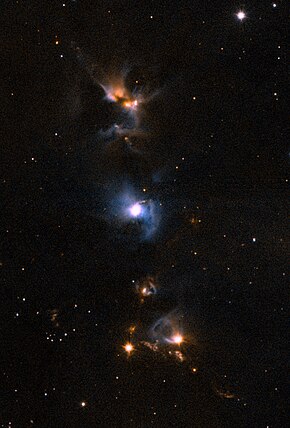| Molecular cloud | |
|---|---|
| Herbig-Haro object | |
 HH 24 (top), HH 25 (below the blue nebula in the middle) and HH 26 (red clouds at the bottom) HH 24 (top), HH 25 (below the blue nebula in the middle) and HH 26 (red clouds at the bottom) | |
| Observation data: J2000.0 epoch | |
| Right ascension | 05 46 07.34 |
| Declination | −00° 13′ 31.3″ |
| Distance | 1300 ly |
| Constellation | Orion |
| Designations | HH 24, HH 25, HH 26, JCMTSF J054607.3-001333, HH 24/26, HH 24-26, HH 24-27 |
| See also: Lists of nebulae | |
HH 24-26 is a molecular cloud and star-forming region containing the Herbig-Haro objects HH 24, HH 25 and HH 26. This region contains the highest concentration of astrophysical jets known anywhere in the sky. The molecular cloud is located about 1400 light-years away in the L1630 dark cloud, which is part of the Orion B molecular cloud in the constellation of Orion.
The region contains multiple protostars (two class 0 and one class I) and four more evolved IRAS sources. The three protostars are driving the Herbig-Haro objects in this region.
Observation
The L1630 dark cloud also contains NGC 2071 and the Flame Nebula. HH 24-26 is located just a few arcminutes south of Messier 78.
HH 24

The image of HH 24 taken by the Hubble Space Telescope is probably the most well known image of this Herbig-Haro object. HH 24 resembles a lightsaber from the science fiction movies Star Wars and the Hubble image was published during the release of Star Wars Episode VII: The Force Awakens.
HH 24 contains a class 0 protostar, which might be a proto-binary system. The disks around these objects are highly misaligned, which is a sign of turbulent fragmentation.
See also
References
- ^ "HH 24-26". SIMBAD. Centre de données astronomiques de Strasbourg. Retrieved 2020-03-04.
- "Searching for Orphan Stars Amid Starbirth Fireworks". Gemini Observatory. 2015-09-25. Retrieved 2020-03-04.
- ^ Benedettini, M.; Giannini, T.; Nisini, B.; Tommasi, E.; Lorenzetti, D.; Di Giorgio, A. M.; Saraceno, P.; Smith, H. A.; White, G. J. (July 2000). "The ISO spectroscopic view of the HH 24-26 region". Astronomy and Astrophysics. 359: 148–158. Bibcode:2000A&A...359..148B. ISSN 0004-6361.
- Gibb, A. G.; Little, L. T. (February 1995). "HH24 26: structure, dynamics and chemistry". Astrophysics and Space Science. 224 (1–2): 467–468. Bibcode:1995Ap&SS.224..467G. doi:10.1007/BF00667908. ISSN 0004-640X. S2CID 189848643.
- Gibb, A. G.; Heaton, B. D. (September 1993). "The star-forming region around HH 24-26 : a revised morphology". Astronomy and Astrophysics. 276: 511–521. Bibcode:1993A&A...276..511G. ISSN 0004-6361.
- "The awakened force of a star". ESA/Hubble. 17 December 2015. Retrieved 2020-03-04.
- Kang, Miju; Choi, Minho; Ho, Paul T. P.; Lee, Youngung (August 2008). "Millimeter Imaging of HH 24 MMS: A Misaligned Protobinary System". Astrophysical Journal. 683 (1): 267–271. arXiv:0805.0451. Bibcode:2008ApJ...683..267K. doi:10.1086/589819. ISSN 0004-637X. S2CID 15843384.
External links
- APOD: 2014 February 4 - A Particle Beam Jet forms HH 24
- APOD: 2015 December 18 - Herbig-Haro 24
- APOD: 2018 March 11 - Dual Particle Beams in Herbig-Haro 24